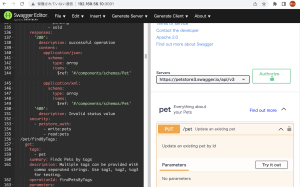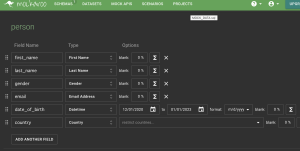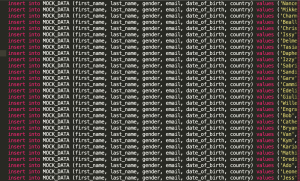sample.yaml
openapi: 3.0.0 info: ... servers: ... paths: ... components: ... security: ... tags: ... exeternalDocs: ....
openapi: バージョンを記載(必須)
info: APIのメタデータ(必須) title, description, termsOfService, contact, license, version
servers: APIを提供するサーバを記述(配列で複数記述可能, 任意)
paths: APIで利用可能なエンドポイントやメソッドを記述(必須)
L put(tag, summary, description, operationId, requestBody(description, contents(application/json, xml, x-www-form-urlencoded), required), responses)
L post(tags, summary, description, operationId, requestBody(description, contents(application/json, xml, x-www-form-urlencoded), required)), response)
L get (tags, summary, description, operationId, requestBody(description, contents(application/json, xml, x-www-form-urlencoded), required)), response, security)
L get (tags, summary, description, operationId, parameters, response)
components: APIで使用するオブジェクトスキーマを記述(必須)
L schimas: type, properties(type(integer, string, array), format(int64, int32, date-time), example, required)
security: API全体を通して使用可能なセキュリティ仕様を記述する(OAuth)
tags: name, description, externalDocs, APIで使用されるタグのリスト。各種ツールによってパースされる際は、記述された順序で出力される。タグ名はユニークでなければならない。(任意)
externalDocs: 外部ドキュメントを記述する(API仕様書)
なるほど、swaggerの仕様を理解するだけで大分違うな…



